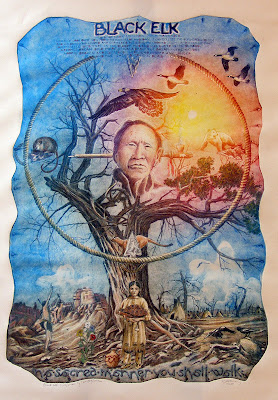

In the “story of a mighty vision given to a man too weak to use it,” (217) Black Elk recounts the moments that have impacted the Lakota people and his role in those events. From beginning to end, Black Elk refuses to acknowledge his strengths in regards to these events and instead focuses on all the negatives. At the age of nine, Black Elk notices “Washichus” effects on the world around him and shortly after has the first of several visions that the “four quarters of the universe” (217) have shared with him. He is ‘the chosen one’ and must now take care of his people, which seems to be a really tough responsibility for a boy at such a young age. He clearly states, however, that they “were warriors at a time when boys now are like girls” (218). While fearful of the visions and his capability of fulfilling his role as a liaison to the spirits, he shares them with the rest of the Lakota people and does all he can in his new found position. Each vision gives insight to the problems the Lakota people will face and assigns him tasks to fulfill to help his people survive among the ongoing changes. Black Elk participates as a key role in several ritualistic celebrations including the sun dance, the horse dance, the heyoka ceremony, the elk ceremony, and the ghost dance. The description of these events, and the visions that have led to them, emphasize the importance of color and number patterns that Black Elk encountered in his visions. Why these things are important, I’m really not sure but I know that they are repeated enough times to be considered important. I personally love the statement about the difference in living in circles and in squares. “It is a bad way to live, for there can be no power in a square… because the Power of the World always works in a circle” (242). When thought of in this way, it makes perfectly good sense that circles are superior to squares. The specific and repeated use of numbers, colors, and shapes creates a beautiful image that can be easily pictured by a reader. The landscape described in the highly detailed narrative allows readers to notice the beauty and simplicity of the Lakota people’s relation to nature. No detail seems too small to be described in full when it comes to nature even when we are not even given a description of Black Elk. Statements made by Black Elk also contribute to importance of nature and the relationship that these visions have allowed him to obtain with it. “And while I stood there I saw more than I can tell and I understood more than I saw” (226). As the years pass there is also a difference in the way Black Elk looks at nature and at his own people. “The fear that was on me so long was gone, and when thunder clouds appeared I was always glad to see them, for they came as relatives now to visit me” (236). Once having feared nature and the probability of their calling to him was now a thing of the past that he wished to continue to experience. “Without them I felt lost, and I was alone there among my people” (237). Black Elk’s years as a medicine man have made him weary of the people around him and made him feel almost as an outcast among those who were truly most like him. In stating this, Black Elk shares that he no longer understands his own people like he once did and now he only understands nature and its way of doing things and he states “it is from understanding that power comes” (245). Black Elk continues to have visions until the age of twenty, unfortunately in the end he is unable to help his people and much change takes place to their way of living. Things happened the way they did for a reason and instead of being able to see it in this way, Black Elk was only able to blame himself for the end of his peoples dream. This is what happens to a lot of good people, they try so hard to do something for everyone and when they fail they can’t help but blame themselves for something that they could not prevent.

No comments:
Post a Comment